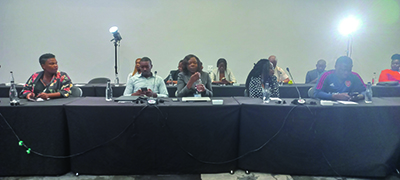By Thoboloko Nts’onyane
JOHANNESBURG- The East, Central, and Southern Africa Health Community (ECSA-HC) under the Tuberculosis In Mining Sector (TIMS) project issued a call to all Southern African Development Community (SADC) journalists to intensively report on TB and advocate for its prevention and control.
These developments transpired during the capacity building training held in Johannesburg, South Africa (SA) last week.
Tuberculosis (TB) remains a major health challenge despite efforts by healthcare professionals and organizations to address the issue.
ECSA-HC Communications and Advocacy Officer Justin Mahimbo said the training is envisaged to capacitate the journalist with the skills necessary to report effectively and informatively on TB related issues.
“You play a very crucial role in shaping public opinion,” he said, adding that the reporting should be rooted in facts and evidence.
Mahimbo highlighted that there has been a spike of TB cases in recent years, particularly in the mining sector, and this he said has become an increasing concern across the southern region.
He said the workshop aims to provide the trainees with the tools and resources to better understand this crisis and it’s far reaching implications.
“By the end of this workshop we hope that she will leave a renewed sense of purpose.”
TIMS Project Coordinator Dr Walter Odoch stressed that TB remains a critical illness within the region highlighting that it does not respect the border territories.
He added: “We still want you [journalists] to tell the stories that it is not the end of the game.”
Dr Odoch urged the participants to amplify the voices on fighting TB across the region and in their countries.
Through their reporting and advocacy efforts, the journalists and the trainees are expected to raise awareness about TB and the urgent need to address it. The tools of trade that they have been capacitated with will also help to dispel misconceptions as well as reducing the stigma surrounding the disease especially in the communities.
Their reporting also helps to hold policymakers and healthcare providers accountable, ensuring that they are aware of the scope of the problem and taking effective action to combat it.
Thanks to the tireless efforts of the journalists and the support of organizations like ECSA-HC, TB became a priority issue in the SADC region. Resources were allocated to address the problem, and new treatment and prevention strategies developed.
The reporting and advocacy efforts of the SADC journalists will help turn the tide against TB in the region.
For her part, the South Africa’s, host country, Director TB at the Department of Health
Dr Lindiwe Mvusi thanked the organizers of the training. She noted that the training was an informative exercise.
Dr Mvusi underscored the compensation element wherein some miners who have contracted it while at work sometimes are not compensated for the disability they acquired as a result of TB. She said the victims of TB in the mines ought to be compensated.
One of the participants from the Zambia National Broadcasting Corporation (ZNBC) Mercy Ngoma praised the initiative saying the training has exposed her the challenges faced in the mining sector.
She said not only the mine should be viewed as those with large capacity processing only but also the TB affects the artisanal miners as well as the surrounding communities.
Ngoma said the training has exposed her on how best to report on issues around TB in the mining sector.
“It [has] also helped me to increase advocacy when it comes to TB. Most of the time when we think of TB, we think well, it’s far from me but at the end of the day if you are not infected, you are affected in a way. So it is important that as media we raise awareness on TB in the mining sector as well as increase access to diagnosis and treatment,” she said.
Asked what the situation is like in Zambia with regard to the TB prevalence, she said there have been efforts made to increase awareness on the disease. She highlighted that even at schools there are debates held around the TB theme.
“Everyone is being covered from young ones and elderly.”
According to the World Health Organisation (WHO) data, in 2021, the estimated burden of TB in Lesotho was 14,000 cases, with an incidence rate of 614 cases per 100,000 population. Of the total TB incidence, 8,700 cases were estimated to be among HIV-positive individuals.
Meanwhile, the estimated proportion of TB cases with multidrug-resistant TB (MDR/RR-TB) was hovering at 3.8% among new cases and 7.7% among previously treated cases.
Lesotho recorded a TB treatment coverage of 32% in 2021, and 19% of TB patients faced high costs in 2019. The estimated TB case fatality ratio in Lesotho was hovering at 40%, and this means that 40% of TB patients who died were not successfully treated for the disease.
The data further show that around 85% of cases were tested with rapid diagnostics at the time of diagnosis, and 97% had a known HIV status. Of the total TB cases, 91% were pulmonary, and 70% were bacteriologically confirmed.
Lesotho is said to have a high burden of TB, particularly among HIV-positive individuals. The estimated proportion of TB cases with MDR/RR-TB is also relatively high in Lesotho.
Despite efforts to increase TB treatment coverage, a significant proportion of TB patients still face catastrophic total costs. Also, the high TB case fatality ratio suggests that there is room for improvement in the management and treatment of TB in Lesotho.
Many SADC member States are yet to domesticate the 2012 “Windhoek Declaration on Tuberculosis Control and Elimination in the SADC Region”. When domesticated, this declaration will address myriad issues including the prevention, control and elimination.
The year 2014 witnessed the WHO’s End TB strategy as part of the Sustainable Development Goals (SDGs). This goal aspires to achieve a 90% reduction in deaths caused by TB by 2030, compared to 2015 levels.
TB is curable. Those infected with this disease are encouraged to seek treatment.


